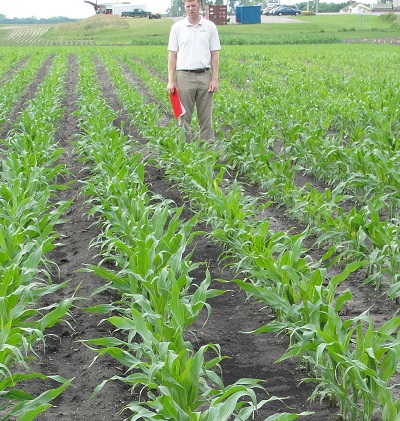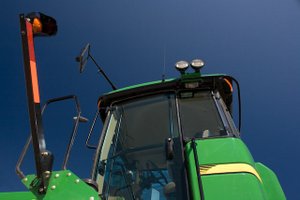When the 2012 crop year started last fall, there were many challenges that were facing the crop 6-8 months before it was even planted. Most of the challenges were derived from the weather or lack of weather specific to rain. There were many changes made to tillage programs last fall in dealing with ground that was less than ideal for preparing for the 2012 crop. Farmers were up to the challenge to prepare an environment in each field that would give them the best chance at producing their best crop for 2012. Last winter we spoke of how climate is what we expect, weather is what we get, and the environment is what we make of it. While there are numerous examples of what weather did to your 2012 crop, I will focus specifically on the environment of each field. I will also discuss how different management practices altered the environment to attain results that lessened the impacts of incremental weather events.
1. Changes made during fall tillage (or the lack of changes) had a large effect on soil conditions at planting.
Keep the clods out of the field and keep the residue high and sized. Fall tillage scenarios in which growers adjusted their equipment to work shallower than normal to keep the soil structure intact kept the ground level while sizing residue, as well as, fracturing the soil to keep the rough clods at bay. By keeping the soil profile intact, the planter was able to plant the crop into a very level seed bed. The residue remained high for the row cleaners to do their job on the planter as well. Even the slightest amount of residue in the seed trench this year caused delayed emergence do the environmental factor of taking a soil profile void of moisture and putting air (residue) next to the seed.
2. Planting date was once again irrelevant.
The old adage of planting early to obtain high yields was once again not seen as we rode machines this fall. Yes, sometime planting early can be advantageous, but top growers always keep in mind that it is the soil conditions at planting time that are the most important factor to producing a top crop, not planting date.
3. Establishing a high ear count was not a challenge due to ideal planting conditions, keeping a high ear count from adverse weather was the #1 challenge that was faced this year.
As stated above, the planting date was irrelevant to final yields. What was relevant was the action taken by growers who faced weather perils early in the year. The effect of a pounding rain on emergence was seen across a wide area. Those that took action and utilized a rotary hoe to help get as many full ears out of the ground were paid huge dividends on final yields. Those that took action in mid-May as the country side turned black with dust from high winds to keep their crop from being set back by sandblasting had a better chance at producing greater yields than those that did nothing.
4. The effects of early season nitrogen applications, as well as, starter fertilizer provided an environment that alleviated stress going into pollination.
In fields where both were applied, the kernel set was outstanding. The plants demand for nitrogen and phosphorus at pollination are at their greatest need. Making sure the plant was fed correctly early in the growing season helped establish a root system that could handle the stresses that were endured during pollination when the plants focus turns to a reproductive state.
5. The focus on bushels per thousand plants instead of plant populations tells the tale of how management and weather affected this year’s crop.
On average (whatever average is) a corn plant will produce approximately 6 Bu per thousand plants. What we saw on combines was a wide variance in what the final number was. We saw ranges of 4 bushel per thousand to 7.25 bushels per thousand across all varieties and fields this year. What were the key factors in producing such a wide difference in the outcome of these yields? The obvious answer is weather. Whether it was early pounding rains or areas where we went 8 weeks without rain, in some instances both were the case for the same field. While the water or lack of water played a role, the differences emerged in how the ground was set up last fall, how well it was planted, and the mindset of the grower to focus on the right agronomic differences to provide a different outcome in the face of the same weather. In areas where wind events caused the lodging or flattening of the crop, we saw what the loss of the photosynthetic factory did in reducing the plants ability to fill the cob, thus reducing the bushels per thousand plants. Keeping in mind that these wind events affected the healthiest, most robust, plants in the field, thus they were more susceptible to catching the wind with greater foliage. When the plant did go down, the final yields were almost based entirely on how well the plant was fed to the specific event when the plant stopped worrying about filling and turned its focus onto making grain that was already on the cob.
6. Drainage matters.
We asked our growers to rank the soil condition at planting, and most of our growers ranked their soil conditions an 8 or 9 on average. What we saw after planting was the adverse way that water, depending on the amount and location in a field, can do to variability in the outcome of the yield. We all know that drainage always pays for itself by way of improving soil conditions at planting, thus equating to even emergence and improved utilization of nutrients in the plant throughout the remainder of the growing season. My hypothesis of the low ground yielding higher this year, in large part due to the lack of water from June through August was quickly proven otherwise on the combines this fall. Even with the same ear count, there were great differences in yields within the field based off of early season water and drainage. Where the water was utilized and drained, the plants ability to get its roots down and continue to search for moisture and nutrients pre-pollination were extremely important. In the poorly drained sections of the field, a shovel quickly provided insight as to how lazy the roots got early in the growing season. Also, when they entered the pollination phase, they had little to nothing to overcome the stress and needs of the plant. Keeping in mind that the plants energy at pollination to fill goes into producing kernels, not roots!
7. Fungicide and foliar nutrients during pollination eliminated undue stress on the plant.
The stress that was seen and observed on the combines was the plants ability to handle heat stress. Even the smallest amount of rainfall after pollination equated to large differences in the cooling of the canopy. The crops roots are their radiator, we all know what happens when a radiator runs with no water in it. The plants roots simply could not keep up with the demands of the environmental factors stressing the plant. By giving the plant a steroid shot, we gained the ability to keep the plant thinking it needs to stay alive and continue to fill in hopes of getting rain to let the roots go back to work. Keeping corn plants alive longer is vital due to the structure of how a corn plant works. Corn is an indeterminate plant. When it senses bad things are going to happen, or death, it focuses all its energy on maturing the kernels it has for reproduction. The corn plant does not care how many kernels it has to reproduce, it only wants to reproduce. What we want is the corn plant to produce as many kernels as possible as that is how we get paid. By spraying the crop at pollination, it came down to a battle of attrition of our wants to keep the plant alive versus the plants wants to die. Many people had questions as to why the beans performed so well in a dry year. The simple answer is in the structure of the bean plant itself. Beans are a determinate plant. The bean plant will shut down almost to the point of death in the face of stress waiting for better times to add flowers, pods, and ultimately beans. We get several chances for the bean to reproduce more flowers to produce more yields, whereas the corn plant only flowers once. The beans waited and waited and finally got what they needed in late July to ultimately determine their final yields. This was especially true where fungicide was applied; it simply allowed the plant more time to focus on reproduction. If you think about why and when fungicides and foliar nutrients were applied this year, it was when the plants were stressed and did not have the abilities to get what they needed from their roots. Whether it was at the V4-V6 stage early in the corn crop, or during pollination in the beans and corn, the plants demands for nutrients were not being met so we had to supplement with foliar applications.
8. Early harvest pays large dividends.
It happened again. Two years in a row where a rapid dry down has occurred. One thing that needs to be noted for future years is that in “stress” years corn needs to be harvested in a timely manner. The timeliness of harvest equated to large differences in yields. As every day passed this fall, Mother Nature was doing her best to steal as much yield away from us as possible. In my years of riding combines I have yet to hear a grower say I wish I would have waited to start combining.
9. Success was based on the mindset of the grower.
Even in years when yield goals may not be achieved, the successes, no matter how big or small, are based on the mindset of the grower. Having the right attitude at planting and maintaining the same problem solving positivity throughout the growing season has and always will equate to greater separation in yields. The mindset starts with 3-5 year yield goals that are then broken down onto a field by field basis. Once the crop plan is developed and in place, the yield building systems begin to take shape. These systems keep all in the operation moving towards the goal of increasing yields, no matter what interference can happen during the growing season. When you deviate from the crop plan, it can turn into a crisis management plan and that simply never works.
 The Farmer’s Almanac used to predict that if corn was knee high by the Fourth of July, it would be a bumper crop. That was a way of measuring, back in our Grandpa’s day. This year we did our planting “back in time”, so will you go back in time to gauge your success next month?
The Farmer’s Almanac used to predict that if corn was knee high by the Fourth of July, it would be a bumper crop. That was a way of measuring, back in our Grandpa’s day. This year we did our planting “back in time”, so will you go back in time to gauge your success next month?






